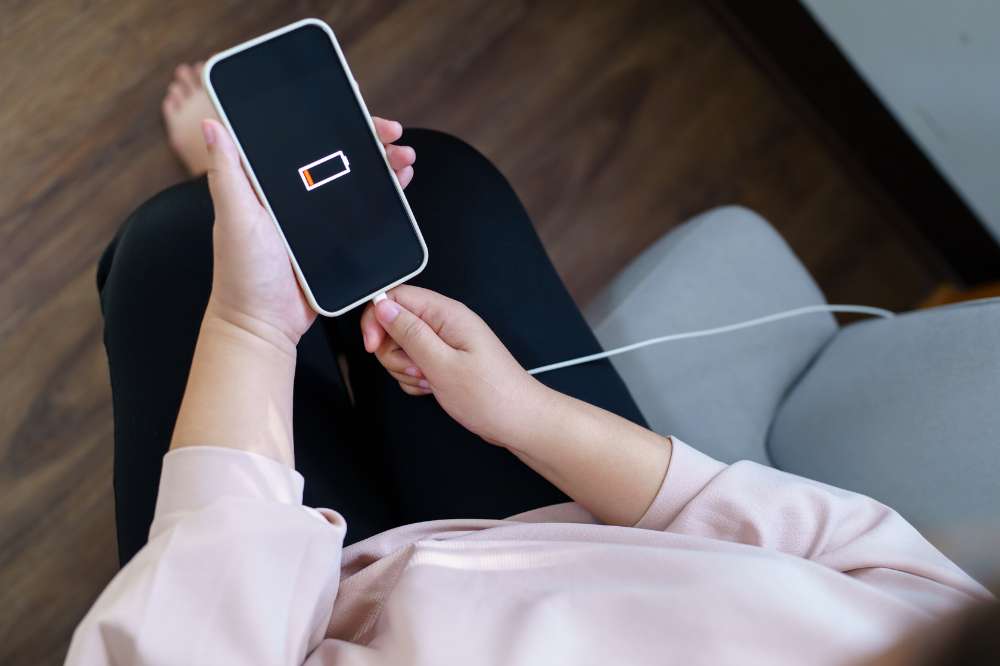In the interconnected tapestry of our modern lives, smartphones stand as indispensable conduits, seamlessly weaving together communication, productivity, and entertainment. Yet, amid the brilliance of these pocket-sized marvels, there exists a common frustration that transcends borders and cultures—the dreaded low battery notification. In the rhythm of our daily hustle, where every beep, buzz, and swipe relies on the life force encapsulated within our mobile devices, extending the longevity of a smartphone’s battery becomes not merely a matter of convenience but a strategic pursuit of efficiency and resilience.
Picture this: You’re navigating through a bustling city, relying on your smartphone for directions, when the battery icon transforms from a reassuring green to a perilous red. Or, during a critical video call, your device desperately clings to its last ounces of power, threatening to abandon you in the midst of a crucial conversation. These scenarios, all too familiar, highlight the pivotal role battery life plays in our digital experiences.
This comprehensive guide embarks on a journey to unravel the intricacies of smartphone battery life—a journey not just for tech enthusiasts but for anyone who depends on their device for tasks mundane and monumental. It’s a journey into the heart of your smartphone, exploring the chemistry of its power source, the dance of its electrons, and the strategic maneuvers you can employ to prolong its vitality.
1. Understanding Battery Basics

No products found.
At the core of every smartphone’s endurance lies its battery—a silent workhorse powering the symphony of apps, calls, and notifications. To comprehend the art of preserving battery life, we must first delve into the fundamental principles governing these energy repositories. Smartphone batteries, predominantly lithium-ion or lithium-polymer, undergo cycles of charging and discharging, a rhythmic dance that defines their lifespan.
Understanding the concept of charging cycles is akin to deciphering the heartbeat of your battery. A charging cycle is completed when you use 100% of your battery’s capacity, whether through a single full charge or several partial charges. The intricate dance between voltage, current, and chemical reactions determines the overall health of your battery.
Temperature, another critical factor, adds its own notes to this symphony. Extreme heat accelerates the aging process of lithium-ion batteries, while extreme cold can temporarily reduce their capacity. Thus, the environmental conditions in which your smartphone thrives or survives significantly impact its long-term battery health.
2. Optimize Display Settings
In the kaleidoscope of smartphone features, the display stands as both canvas and spectator, bringing digital experiences to vivid life. However, the brilliance of these screens comes at a cost—power consumption. As we gaze into the dazzling landscapes of high-resolution displays, it’s crucial to navigate the delicate equilibrium between visual splendor and energy efficiency.
Brightness, the Illuminator:
The luminance of your smartphone display is not just an aesthetic preference; it’s a key player in the energy consumption game. Many users tend to keep their screen brightness at maximum, believing it enhances visibility. While this might be true under direct sunlight, it’s a power-hungry choice in indoor or low-light environments.
Optimal brightness settings strike a balance, ensuring visibility without unnecessary strain on your battery. Consider adjusting your brightness dynamically based on ambient light. Many smartphones offer adaptive brightness features that automatically adjust the screen’s luminance according to surrounding conditions. Embracing this smart feature not only conserves battery but also adapts to diverse lighting scenarios seamlessly.
Timeout Tactician:
Beyond brightness, the screen timeout duration dictates how long your display remains active when not in use. A common habit is to set an extended timeout duration, allowing more leisurely moments between interactions. However, this leisure comes at the cost of prolonged screen-on time and increased battery consumption.
Shortening the screen timeout to the minimum duration required ensures that your display powers down promptly when idle. This seemingly minor adjustment contributes significantly to energy savings, especially in situations where your smartphone remains untouched for extended periods. An inactive, brightly lit screen is essentially a silent drain on your battery, and strategic timeout settings act as the gatekeeper, preserving energy for when you truly need it.
3. Manage App Usage and Background Processes
Apps play a central role in our smartphone experience, but their influence extends beyond the moments we actively use them. Many apps continue running in the background, consuming precious battery power. Managing app usage and background processes is crucial for efficient battery life.
Identify battery-draining apps by reviewing battery usage statistics in your device settings. Some apps run unnecessary background processes that can be disabled without compromising functionality. Adjusting app settings to limit background activity, particularly for apps that don’t require real-time updates, can significantly reduce battery drain.
Consider consolidating notifications to minimize app interruptions and reduce the frequency of background updates. This not only conserves battery but also declutters your notification center, creating a more focused and efficient user experience. By taking control of your app ecosystem, you pave the way for a more sustainable battery life.
4. Connectivity and Location Settings
Connectivity features such as Wi-Fi, Bluetooth, and GPS contribute to the versatility of smartphones but can also be substantial power consumers. Understanding how these features impact battery life and adopting strategic usage patterns can significantly extend your device’s uptime.
Wi-Fi is generally more energy-efficient than mobile data, so connecting to Wi-Fi networks whenever possible conserves battery life. Similarly, Bluetooth, when not in use, should be turned off to prevent unnecessary power consumption. GPS, while invaluable for navigation, can be a major drain on the battery. Use location services selectively, turning them off for apps that don’t require precise location information.
Additionally, modern smartphones often include power-saving modes that automatically adjust connectivity settings based on battery levels. Enabling these modes during periods of low battery can be a proactive approach to conserving energy without sacrificing essential functions.
5. Update Software Regularly
Software updates aren’t just about introducing new features; they often include optimizations and bug fixes that can positively impact battery efficiency. Keeping your smartphone’s operating system and apps up to date is a simple yet effective strategy for maintaining optimal performance.
Operating system updates, such as those released by Android or iOS, may include battery optimizations and enhancements to background processes. App developers regularly release updates to address performance issues and refine energy consumption. Set your device to automatically update software or regularly check for updates to ensure you’re benefiting from the latest improvements.
In addition to system updates, be mindful of app permissions. Some apps request unnecessary permissions that can contribute to increased battery drain. Review and adjust app permissions in your device settings to limit background activity and enhance overall battery efficiency.
6. Utilize Battery-Saving Modes
Most smartphones come equipped with battery-saving or power-saving modes designed to optimize performance and conserve energy during critical moments. Understanding when and how to activate these modes can be a game-changer for extending battery life.
Battery-saving modes typically adjust various settings, such as screen brightness, CPU performance, and background processes, to reduce power consumption. While these modes may slightly limit certain functionalities, they provide a significant boost to battery longevity. Consider activating these modes during periods of low battery or when you anticipate extended periods without access to a charger.
It’s worth exploring the specific features of your device’s battery-saving mode. Some smartphones allow users to customize which aspects are adjusted, providing a tailored approach to battery optimization. By incorporating battery-saving modes into your battery management strategy, you gain more control over energy consumption without sacrificing essential functionality.
7. Choose the Right Charging Practices
Charging your smartphone is a routine activity, but how you approach it can have a profound impact on battery health and longevity. By adopting smart charging practices, you can optimize your device’s battery performance and mitigate factors that contribute to degradation.
Firstly, avoid letting your battery level drop to extremely low percentages regularly. Lithium-ion batteries, common in smartphones, prefer staying within a moderate charge range. Aim to keep your battery level between 20% and 80% for optimal longevity. Contrary to popular belief, frequent small top-up charges are generally better for battery health than waiting until your phone is nearly depleted.
Consider using a high-quality charger supplied by the manufacturer or a reputable third-party charger that meets your device’s specifications. Fast charging technologies, while convenient, can generate more heat and contribute to faster battery degradation over time. If you’re not in a rush, opting for standard charging can be gentler on the battery.
Furthermore, be mindful of environmental factors. Avoid exposing your device to extreme temperatures while charging, as both high and low temperatures can impact battery health. Charging your smartphone in a well-ventilated area and removing it from cases during charging can help dissipate heat, contributing to a healthier charging process.
8. Evaluate and Replace Aging Batteries
Smartphone batteries, like any rechargeable batteries, have a finite lifespan. Over time, you may notice a decline in battery performance, including shorter usage times and quicker drainage. Understanding the signs of battery degradation and knowing when to consider battery replacement is essential for maintaining optimal performance.
If you find your smartphone struggling to hold a charge, experiencing unexpected shutdowns, or displaying erratic battery percentages, it may be indicative of a worn-out battery. Some smartphones provide battery health information in their settings, allowing users to monitor the battery’s maximum capacity. A significant drop in maximum capacity over time signals the need for replacement.
When it comes to battery replacement, it’s advisable to seek professional services or follow manufacturer guidelines. Attempting to replace the battery yourself can lead to unintended damage. Many smartphone manufacturers offer battery replacement services, ensuring a safe and reliable replacement process.
By staying vigilant to the signs of aging batteries and proactively seeking replacement when needed, you contribute to the overall health and longevity of your smartphone. This not only extends your device’s lifespan but also reduces electronic waste, aligning with sustainable technology practices.
9. Explore Battery Monitoring Apps
Harnessing the power of technology to manage technology, battery monitoring apps offer insights into your device’s energy consumption patterns. These apps provide detailed information about which apps and processes are consuming the most power, empowering users to make informed adjustments.
Battery monitoring apps typically display real-time and historical data on battery usage, temperature, and charge cycles. By analyzing this information, users can identify energy-intensive apps, track the impact of settings adjustments, and gain a holistic view of their battery’s health.
Some monitoring apps offer customizable alerts, notifying users when battery levels reach certain thresholds or when energy-consuming apps are active in the background. By staying informed and proactive, users can take timely actions to conserve energy and optimize their device’s battery life.
When exploring battery monitoring apps, prioritize those with positive reviews, transparent data reporting, and minimal impact on system resources. An effective battery monitoring app should enhance your understanding of your device’s energy dynamics without becoming an additional burden on performance.
10. Miscellaneous Tips and Tricks
Beyond the major strategies discussed, there are several smaller yet impactful tips and tricks that collectively contribute to a more enduring battery life. Consider these additional adjustments to fine-tune your battery management strategy:
- Manage Widgets: While widgets offer quick access to information, they can also contribute to battery drain. Evaluate the necessity of widgets on your home screen and remove those that are not essential.
- Reduce Animation Effects: Animated wallpapers and transition effects, while visually appealing, consume additional processing power. Minimize these effects in your device settings to streamline performance and conserve battery.
- Avoid Extreme Temperatures: Exposure to extreme temperatures, whether hot or cold, can affect battery performance. Avoid leaving your smartphone in direct sunlight or in freezing conditions for extended periods.
- Limit Background Syncing: Some apps sync data in the background, even when you’re not actively using them. Review and adjust sync settings for apps to minimize unnecessary data transfers and preserve battery.
These miscellaneous tips, when implemented collectively, contribute to a more efficient and sustainable battery management approach. Tailor these adjustments to your usage patterns and preferences to strike the right balance between functionality and energy conservation.
Conclusion
In the fast-paced world of technology, where smartphones are essential companions, mastering the art of extending battery life is a practical skill. By understanding the nuances of battery basics, optimizing settings, and adopting smart charging practices, users can significantly enhance their device’s longevity and reduce the frequency of frustrating low battery moments.
This comprehensive guide has explored various aspects of smartphone battery management, from fundamental principles to nuanced tips and tricks. Implementing these strategies not only ensures a more enduring battery life but also contributes to sustainable technology practices by reducing electronic waste.
As technology continues to evolve, users armed with knowledge about battery efficiency are better equipped to make informed decisions. Embrace these techniques, adapt them to your unique needs, and experience a more resilient and enduring smartphone battery performance in the digital age.



